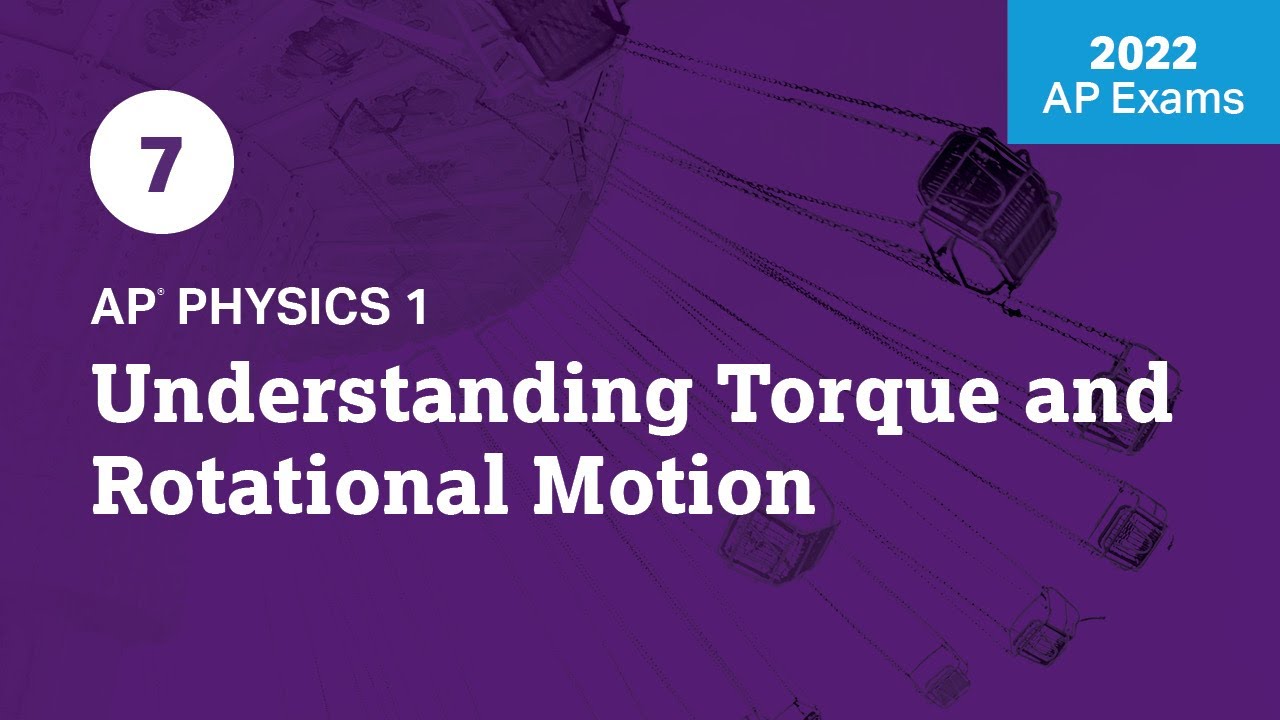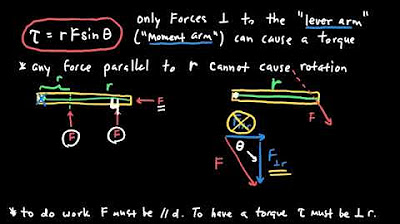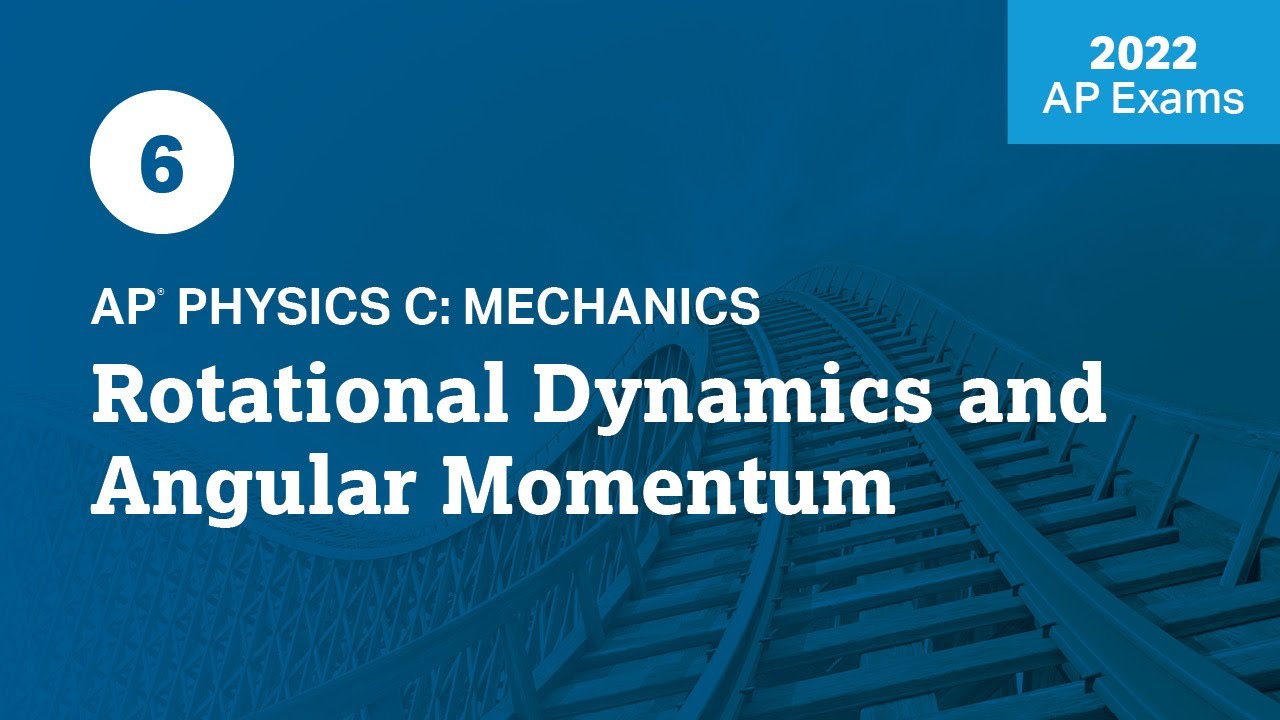AP Physics 1 review of Torque and Angular momentum | Physics | Khan Academy
TLDRThis transcript delves into the principles of rotational motion, exploring the rotational kinematic formulas that relate angular displacement, velocity, and acceleration to linear counterparts. It explains concepts such as torque, rotational inertia, and angular momentum, highlighting their significance in physics. The script also touches on the conservation of angular momentum and the calculation of rotational kinetic energy and gravitational potential energy, offering insights into how these physical quantities govern the behavior of objects in motion.
Takeaways
- 📐 **Rotational Kinematic Formulas**: These relate five rotational motion variables, analogous to linear kinematic formulas but with angular displacement, initial/final angular velocities, angular acceleration, and time.
- 🔄 **Angular Displacement**: It represents the angle an object rotates through in a given time, t.
- 🌀 **Angular Velocity vs. Speed**: Angular velocity is the angle rotated per unit time, similar to how speed is displacement per unit time.
- 🚀 **Angular Acceleration**: This is the change in angular velocity per unit time, akin to linear acceleration being change in speed per unit time.
- 🔧 **Torque**: Torque causes angular acceleration, just as force causes linear acceleration. It is dependent on the force applied and the distance from the axis of rotation (r).
- 🎯 **Rotational Equilibrium**: An object is in rotational equilibrium when the net torque is zero, resulting in zero angular acceleration, similar to translational equilibrium with net force being zero.
- 🌈 **Moment of Inertia**: Also known as rotational inertia, it quantifies an object's resistance to angular acceleration. It can be increased by placing mass farther from the axis of rotation.
- 📐 **Calculating Moment of Inertia**: For objects with mass distributed at a uniform radius, the moment of inertia is given by I = mr^2, where m is the mass and r is the radius.
- 💡 **Angular Version of Newton's Second Law**: The angular acceleration (α) is equal to the net torque (M) divided by the rotational inertia (I), or α = M/I.
- 🔄 **Rotational Kinetic Energy**: This is given by the formula KE = 1/2 * I * ω^2, where I is the moment of inertia and ω is the angular velocity.
- 🌐 **Conservation of Angular Momentum**: In a system with no external torque, the angular momentum is conserved. It is given by L = I * ω for extended objects or L = mv * r for point masses.
- 🌠 **Gravitational Potential Energy**: The more general formula for gravitational potential energy between two masses is given by U = -G * (m1 * m2) / r, where G is the gravitational constant, m1 and m2 are the masses, and r is the center-to-center distance.
Q & A
What are the rotational kinematic formulas and how do they relate to the regular kinematic formulas?
-The rotational kinematic formulas relate the five different rotational motion variables, similar to the regular kinematic formulas but with angular displacement, initial and final angular velocities, and angular acceleration instead of displacement, velocity, and acceleration. The time variable remains the same. These formulas are only true if the angular acceleration is constant.
What is angular displacement and how is it different from linear displacement?
-Angular displacement is the amount of angle an object has rotated through in a certain amount of time. It is different from linear displacement, which is the change in position of an object along a straight line.
How is angular velocity defined and what is its relationship with linear velocity?
-Angular velocity is defined as the amount of angle rotated through per unit of time, similar to how linear velocity is the displacement per unit of time. Both quantities describe the rate of motion, but angular velocity pertains to rotational motion while linear velocity pertains to translational motion.
What is the relationship between angular acceleration and linear acceleration?
-Angular acceleration is defined as the rate of change of angular velocity per unit of time, just as linear acceleration is the rate of change of linear velocity per unit of time. Both describe how the velocity changes, but angular acceleration is specific to rotational motion.
How can you calculate the arc length an object has traveled through during rotation?
-To calculate the arc length (s) an object has traveled through during rotation, you multiply the radius of the circular path by the amount of angular displacement.
What is the formula for calculating the speed of an object in circular motion?
-The speed of an object in circular motion can be calculated by multiplying the radius of the path by the angular speed of the object.
What is the difference between tangential acceleration and centripetal acceleration?
-Tangential acceleration causes the object to speed up or slow down and is calculated by multiplying the radius of the path by the angular acceleration. Centripetal acceleration, on the other hand, is the acceleration that causes the object to change direction and is given by the formula v^2/r, where v is the linear speed and r is the radius of the circular path.
What is torque and how does it relate to angular acceleration?
-Torque is the rotational equivalent of force and is what causes angular acceleration. It is the product of the force applied and the distance from the axis of rotation (r), maximized when the force is applied perpendicular to the line from the axis to the point of application. Torque is necessary for an object to speed up or slow down in its angular motion.
How does the location of the force application affect the torque produced?
-The torque produced depends on where the force is applied. If the force is exerted farther from the axis of rotation, more torque is generated for a given amount of force. The torque is maximized when the force is applied perpendicular to the line from the axis to the point of application.
What is rotational inertia and how does it affect an object's resistance to angular acceleration?
-Rotational inertia, also known as the moment of inertia, is a measure of an object's resistance to angular acceleration. An object with a large rotational inertia will be harder to get rotating and stop rotating. It depends on the mass distribution relative to the axis of rotation; placing mass farther from the axis increases the rotational inertia.
How can you calculate the moment of inertia for different objects?
-The moment of inertia (I) can be calculated using various formulas depending on the object's shape and mass distribution. For a solid cylinder or disk, I = 1/2 m*r^2, where m is the mass and r is the radius. For a hollow cylinder or hoop, I = m*r^2. For a rod rotating about its center, I = 1/12 m*L^2, and for a rod rotating about one end, I = 1/3 m*L^2, where L is the length of the rod.
What is the angular version of Newton's Second Law and how is it applied?
-The angular version of Newton's Second Law states that the angular acceleration (α) is equal to the net torque (M) divided by the rotational inertia (I). It is used to determine the angular acceleration of an object when the net torque and the moment of inertia are known.
How does rotational kinetic energy differ from translational kinetic energy?
-Rotational kinetic energy is associated with an object's rotation and is given by the formula 1/2 I * ω^2, where I is the moment of inertia and ω is the angular velocity. Translational kinetic energy, on the other hand, is associated with the linear motion of an object's center of mass and is given by the formula 1/2 m * v^2, where m is the mass and v is the linear velocity.
What is angular momentum and why is it conserved in a system with no external torque?
-Angular momentum is the rotational equivalent of linear momentum and is given by the formula I * ω, where I is the moment of inertia and ω is the angular velocity. It is conserved in a system with no external torque because the net external torque that could change the system's angular momentum is zero.
How can you calculate the angular momentum of a point mass moving in a straight line?
-The angular momentum of a point mass moving in a straight line can be calculated by multiplying the mass (m) by the velocity (v) and by the distance of closest approach (R) to the axis of rotation, or by multiplying m * v by the sine of the angle between the velocity vector and the radial vector (r) pointing from the axis to the point mass.
What is the more general formula for gravitational potential energy and when is it used?
-The more general formula for gravitational potential energy between two masses (m1 and m2) is given by -G * (m1 * m2) / r, where G is the gravitational constant and r is the center-to-center distance between the two masses. This formula is used when the gravitational field is varying, unlike the simpler mgh formula that assumes a constant gravitational field.
How does the gravitational potential energy between two masses change as they move closer together?
-As two masses move closer together, the gravitational potential energy becomes more negative because the potential energy is always negative and its magnitude increases as the distance between the masses decreases. This is due to the negative sign in the gravitational potential energy formula, which indicates that energy is stored when objects are attracted to each other.
Outlines
📚 Introduction to Rotational Kinematics
This paragraph introduces the concept of rotational kinematics, drawing parallels with linear kinematics. It explains the rotational motion variables: angular displacement, initial and final angular velocities, angular acceleration, and time. The paragraph emphasizes that only the first two variables are provided on the AP exam formula sheet. The discussion continues with the meaning of each variable, such as angular displacement being the angle rotated through in a given time and angular velocity being the rate of rotation. The relationships between angular and linear quantities are also highlighted, including how to calculate arc length, speed, and tangential acceleration. The paragraph concludes with an example problem involving the three types of accelerations in an object rotating at a constant rate.
🔧 Understanding Torque and Rotational Inertia
This section delves into the concept of torque, which causes angular acceleration, and rotational inertia, which resists changes in angular velocity. Torque is the rotational equivalent of force and is maximized when force is applied perpendicular to the lever arm (r). The example of a rod in rotational equilibrium is used to illustrate how torques from different forces balance out. The paragraph then explains rotational inertia, or the moment of inertia, which is a measure of an object's resistance to angular acceleration. It describes how the distribution of mass affects rotational inertia and provides formulas for calculating the moment of inertia for various objects like rods, spheres, and hoops. An example problem compares two cylinders with different mass distributions to determine which would roll down a hill first.
📐 Angular Version of Newton's Second Law and Kinetic Energy
This paragraph discusses the angular version of Newton's Second Law, which relates net torque to rotational inertia and angular acceleration. An example is provided to calculate the angular acceleration of a rod with given forces and rotational inertia. The concept of rotational kinetic energy is introduced, with its formula and the conditions under which an object possesses it. The paragraph contrasts rotational kinetic energy with translational kinetic energy and provides an example problem involving a cylinder gaining rotational kinetic energy over time due to a constant torque. The discussion concludes with an explanation of angular momentum, its conservation in the absence of external torque, and its calculation for both point masses and extended objects.
🌐 Gravitational Potential Energy and Conservation of Energy
The final paragraph addresses the more general formula for gravitational potential energy, which is necessary when dealing with a varying gravitational field. It contrasts this formula with the familiar mg formula used in uniform gravitational fields. The conservation of energy principle is applied to an example problem where two spheres fall towards each other, and the conversion of gravitational potential energy into kinetic energy is calculated. The paragraph concludes by reiterating that while gravitational potential energy is always negative, it can still be transformed into kinetic energy, and provides the formula for this energy transformation.
Mindmap
Keywords
💡Rotational Kinematic Formulas
💡Angular Displacement
💡Angular Velocity
💡Angular Acceleration
💡Torque
💡Rotational Inertia
💡Centripetal Acceleration
💡Gravitational Potential Energy
💡Angular Momentum
💡Rotational Kinetic Energy
Highlights
Rotational kinematic formulas relate five different rotational motion variables, analogous to regular kinematic formulas but with angular displacement, initial/final angular velocities, and angular acceleration.
Only the first two rotational motion variables are provided on the AP exam formula sheet, not three and four.
Angular displacement is the amount of angle an object has rotated through in a certain amount of time t.
Angular velocity is defined as the amount of angle rotated through per unit of time, similar to regular velocity being displacement per time.
Angular acceleration is the amount of change in angular velocity per unit of time, akin to regular acceleration being the change in velocity per time.
For circular motion, angular velocity points perpendicular to the plane of rotation, and can be thought of as counterclockwise or clockwise.
The arc length s is obtained by multiplying the radius of the path by the angular displacement.
The speed of an object in circular motion is found by multiplying the radius of the path by the angular speed.
Tangential acceleration is calculated by multiplying the radius of the path by the angular acceleration, and it causes the object to speed up or slow down.
Centripetal acceleration, which changes the direction of an object in circular motion, is given by the formula v squared over r.
Torque is what causes angular acceleration, similar to how force causes regular acceleration.
The effectiveness of a torque depends on where the force is exerted; the farther from the axis of rotation, the more torque for a given force.
Rotational equilibrium occurs when the net torque is zero, leading to zero angular acceleration, similar to translational equilibrium with net force and acceleration.
Rotational inertia, also known as the moment of inertia, determines how much an object resists angular acceleration.
An object's rotational inertia can be increased by placing its mass farther from the axis of rotation.
The formula for calculating an object's moment of inertia is I equals the mass times the distance from the axis squared (I = mr^2).
The angular version of Newton's Second Law states that angular acceleration is equal to the net torque divided by the rotational inertia.
Rotational kinetic energy is given by half the moment of inertia times the angular speed squared (1/2Iω^2).
Angular momentum is conserved for a system with no external torque and is calculated as the rotational inertia times the angular velocity.
Gravitational potential energy between two masses is calculated as the negative of the gravitational constant times the product of the two masses divided by the center-to-center distance.
In a system with no external work done, the sum of gravitational potential energy, kinetic energy, and rotational kinetic energy remains constant (conservation of energy).
Transcripts
Browse More Related Video

2022 Live Review 7 | AP Physics 1 | Understanding Torque and Rotational Motion

AP Physics 1 Torque and Rotational Motion Review

2022 Live Review 6 | AP Physics C: Mechanics | Rotational Dynamics and Angular Momentum

Torque: Crash Course Physics #12

Rotational kinematic formulas | Moments, torque, and angular momentum | Physics | Khan Academy

Rotation Free Response Paragraph Questions (AP Physics 1)
5.0 / 5 (0 votes)
Thanks for rating: